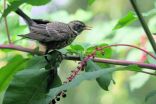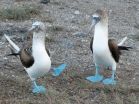(Press-News.org) Researchers have pinpointed a primary cause of a rare skull disorder in infants, and the discovery could help wounded soldiers, car-wreck victims and other patients recover from disfiguring facial injuries.
"This has a lot more implication than what we initially thought," said Yang Chai, a lead researcher on the study at the Herman Ostrow School of Dentistry of USC. "We can take advantage of these stem cells not only to repair a birth defect, but to provide facial regeneration for veterans or other people who have suffered traumatic injury."
Chai predicted such treatment could be available to patients within the next five to 10 years, providing it shows promise in clinical trials with human patients.
"It is a very minimal procedure to just cut off a strip of bone instead of cutting the entire calvaria [skull cap]," Chai said. A stem cell treatment "will truly restore the normal anatomy, which will then be able to respond to the continuous brain growth and the patient can live a normal life."
The team's findings also have shifted the scientific perspective on bone disease, according to Hu Zhao, who conducted most of the study's tests on mice.
"Before our findings, people just assumed the bones all around the body are the same," Zhao said. "We are now showing that they are all totally different, that they have a different source of stem cells and a different healing mechanism."
In their study on mice, the team tracked Gli1+ stem cells that appear within the tissues that connect craniofacial bones. The researchers found that a shortage of Gli1+ stem cells hardened the skull and fused the sutures, causing "craniosynostosis," a birth defect that can hinder brain development. The researchers also tested whether Gli1+ stem cells serve another purpose by transplanting them into injured mice.
Within weeks, researchers noticed that the Gli1+ stem cells were migrating to repair injured areas of the skull.
Chai said the discovery that Gli1+ stem cells regenerate means that doctors will be able to help people who have suffered disfiguring facial injuries and infants diagnosed with craniosynostosis through biological means instead of multiple, high-risk surgeries.
Until now, the surgeons had unknowingly destroyed the regenerative stem cells when operating on craniosynostosis patients.
During a typical surgery, doctors break the skull into multiple pieces, staple them together and then discard tissues as waste. Zhao said the procedure, intended to aid brain growth, actually interferes with healing because the Gli1+ stem cells are lost.
Chai said a biological approach -- transplanting Gli1+ stem cells into targeted areas -- could give infants with craniosynostosis the flexibility that they need for their brains to grow normally. For other patients who have suffered head trauma or facial disfigurement, the Gli+1 stem cells could repair fractured or injured areas.
Researchers plan to conduct additional experiments before the treatment is tested in clinical trials with patients.
"One of our ideas is that we could probably use those healthy sutures and the healthy pieces from them and transplant them on the injured sides," Zhao said.
INFORMATION:
The findings were published in this month's issue of the journal Nature Cell Biology. The study was supported by grants to Chai from the National Institute of Dental and Craniofacial Research at the National Institutes of Health.
SAN FRANCISCO--More than 143 million Americans living in the 48 contiguous states are exposed to potentially damaging ground shaking from earthquakes, with as many as 28 million people likely to experience strong shaking during their lifetime, according to research discussed at the annual meeting of Seismological Society of America. The report puts the average long-term value of building losses from earthquakes at $4.5 billion per year, with roughly 80 percent of losses attributed to California, Oregon and Washington.
"This analysis of data from the new National Seismic ...
WEST LAFAYETTE, Ind. - A Purdue University study sheds light on how cell damage is reversed by the cancer drug decitabine and identifies a potential biomarker that could indicate a patient's stage of cancer and response to treatment.
A team led by Joseph Irudayaraj, professor of agricultural and biological engineering, showed that decitabine combats some of the effects of cancer by taking the place of the nucleotide cytosine at specific locations on a replicating DNA strand. By mimicking cytosine, the drug helps "tame" cancerous cells by turning on tumor suppressor genes ...
The immune-boosting properties of breast milk have long been known. Now a team of scientists led by Johns Hopkins pediatric surgeon-in-chief David Hackam, M.D., Ph.D., says experiments in mice reveal how breast milk works to ward off the development of necrotizing enterocolitis (NEC), a devastating intestinal disorder that affects 12 percent of premature babies and claims the lives of one in four of those who have it.
If affirmed in human studies, the experiments could pave the way to new preventive approaches to stave off NEC in premature babies and spark the development ...
Over the past few years, extracellular vesicles, or membrane sacs secreted from cells, have emerged as important mediators by which cells communicate with their surroundings to regulate a diverse range of biological processes. In addition, specialized roles for extracellular vesicles are beginning to be recognized in various diseases including cancer, infectious diseases and neurodegenerative disorders. Moreover, engineered extracellular vesicles are likely to have applications in drug delivery.
The laboratory of Crislyn D'Souza-Schorey, Morris Pollard Professor and Chair ...
Beverages sweetened with low, medium and high amounts of high-fructose corn syrup significantly increase risk factors for cardiovascular disease, even when consumed for just two weeks by young, healthy men and women, reports a team of researchers at the University of California, Davis.
The study is the first to demonstrate a direct, dose-dependent relationship between the amount of added sugar consumed in sweetened beverages and increases in specific risk factors for cardiovascular disease.
The data reinforce evidence from an earlier epidemiological study showing that ...
COLUMBIA, Mo. -Due to the ever-increasing number of people using social media sites such as Facebook and Twitter, businesses and organizations, such as professional sports teams, are expanding their marketing and communication efforts to engage people with their brands through those sites. Now, Nicholas Watanabe, an assistant teaching professor at the University of Missouri, along with colleagues from MU and Louisiana State University, analyzed Major League Baseball (MLB) teams' use of Twitter to engage and increase fan interest. They found that the more individual teams ...
LEXINGTON, KY. (Apr. 22, 2015) -- It was once thought that effects of a mild head injury -- dizziness, headaches, memory problems -- were only temporary, and the brain would heal over time. However, while the long-term consequences of head trauma are not fully known, growing evidence suggests that even a mild head injury can increase the risk for later-in-life development of dementias such as Alzheimer's disease.
Researchers at the University of Kentucky's Sanders-Brown Center on Aging have been attempting to understand the cascade of events following mild head injury ...
From AGU's blogs: Volcanic soundscapes reveal differences in undersea eruptions
New research matching different types of underwater volcanic eruptions with their unique sound signatures could help scientists better detect and understand emissions occurring on the seafloor.
From Eos.org: Is the Shale Boom Reversing Progress in Curbing Ozone Pollution?
Concentrations of volatile organic compounds--precursors to ground-level ozone formation--are on the rise in areas over and downwind of a major shale oil and gas field in Texas.
From AGU's journals: When the Sun ...
How aware are you of the birds that live in your neighborhood? Do you know how many different species there are? Do enjoy your local birds, or find them annoying? J. Amy Belaire of St. Edward's University, Lynne Westphal of the U.S. Forest Service, and Emily Minor and Christopher Whelan of the University of Illinois at Chicago visited urban neighborhoods in the Chicago area to answer these questions and learn more about how people see their backyard birds. Their results, published in a new paper in The Condor: Ornithological Applications, provide a fascinating look at the ...
Life as a wild baby bird can involve a lot of stress; competing with your siblings, dealing with extreme weather, and going hungry due to habitat loss are just a few examples. However, birds have an amazing capacity to overcome stresses experienced early in life and go on to reproductive success as adults, according to a new Perspective paper in The Auk: Ornithological Advances by Hugh Drummond and Sergio Ancona of the Universidad Nacional Autónoma de México.
Some experiments with birds in captivity have found that increasing early-life stress through food deprivation, ...

